Before moving to the Seattle area nine years ago, I was a Southern California girl. That’s right, sun, sun and more sun. I’ll admit, at first I was a bit intimidated by planting in shade.
In hindsight, it’s clear my nervousness stemmed from lack of knowledge. Now I’m drawn to shade gardens and all their lushness. From brilliant greens to warm golds, fabulous foliage to phenomenal flowers, shade gardens have the ability to sparkle and shine just as much as the brightest garden for sun. Here’s a selection of sumptuous combos to get you started on planning that partially shaded border or neglected dark corner.
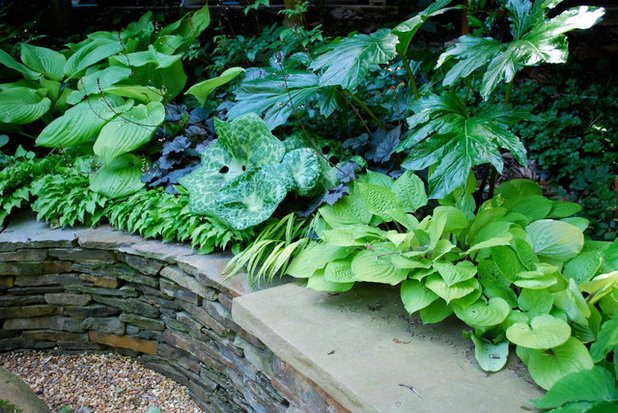
Jay Sifford Garden Design
Foliage First
1. Oversized foliage. It’s easy to be seduced by flowers, but as one of my favorite sayings goes, foliage first. Here we see a mix of foliage types and textures, all commingling to create a vignette full of interest in this mid-Atlantic garden. Note how the matte foliage of the hostas balances the glossy leaves of the bear’s breeches, and finely textured Japanese forest grass grows under the broad mayapple. The variety allows the eye to travel throughout the scene in search of more detail.
Plant combo (click each photo to see the plants tagged):
- ‘Spotty Dotty’ Chinese mayapple (Podophyllum ‘Spotty Dotty’, USDA zones 6 to 9; find your zone)
- Golden Japanese forest grass (Hakonechloa macra ‘Aureola’, zones 4 to 9)
- Bear’s breeches (Acanthus mollis, zones 7 to 9)
- ‘Frosted Violet’ coral bells (Heuchera ‘Frosted Violet’, zones 4 to 9)
- ‘Sum and Substance’ plantain lily (Hosta ‘Sum and Substance’, zones 3 to 8)
Light requirement: Full to partial shade
Water requirement: Medium; occasional water during dry months
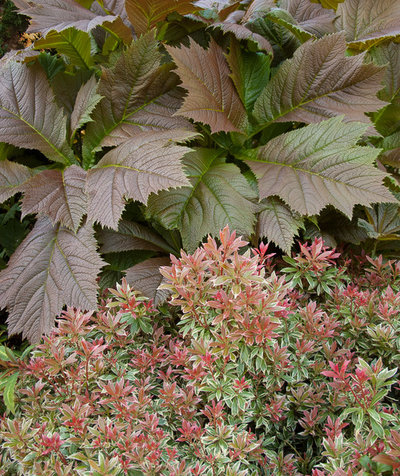
Le jardinet
2. Same color, different size. Here, the brick red of the rodgersia is echoed in the ‘Little Heath’ andromeda. Even the leaf shapes are similar. The striking contrast in foliage size makes this pairing in a Pacific Northwest garden successful.
Plant combo:
- ‘Rotlaub’ rodgersia (Rodgersia podophylla ‘Rotlaub’, zones 4 to 9)
- ‘Little Heath’ Japanese andromeda (Pieris japonica ‘Little Heath’, zones 5 to 9)
Light requirement: Partial sun to shade
Water requirement: Medium; occasional water during dry months
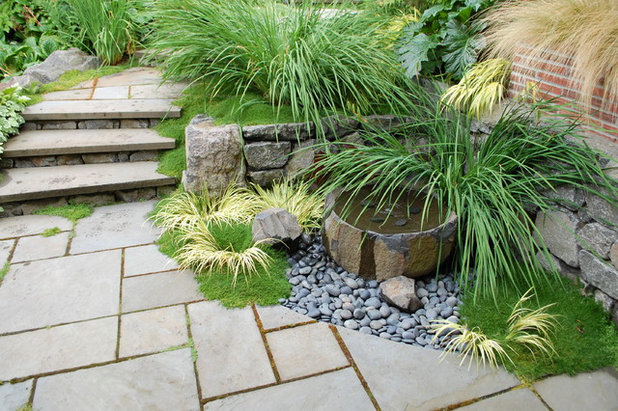
Avalon Northwest Landscape, LLC
3. A single foliage type. Don’t be afraid to choose a single foliage type for a section of your shade garden. Add interest by mixing foliage sizes and colors. In this Seattle garden, strappy rules the scene.
Plant combo:
- Siberian iris (Iris sibirica ‘Caesar’s Brother’ and I. sibirica ‘Ruffled Velvet’, zones 3 to 8)
- Golden sweet flag (Acorus gramineus ‘Ogon’, zones 5 to 9)
- Irish moss (Sagina subulata, zones 4 to 8)
Light requirement: Full sun to partial shade
Water requirement: Regular water
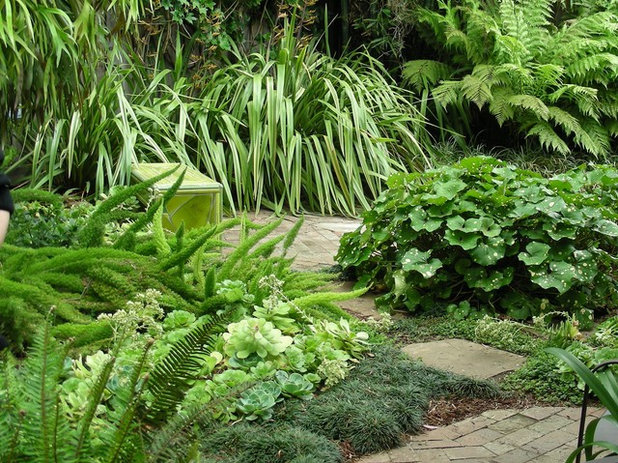
Billy Goodnick Garden Design
4. All mixed up. On the flip side, you can go all-out with a full mix of foliage shapes, sizes and textures. Who says less is more, right? Find at least one element that ties the combination together. The dazzling array of greens
makes this planting in a Santa Barbara, California, garden successful.
Plant combo:
- Leopard plant (Farfugium japonicum ‘Aureomaculatum’, zones 7 to 12)
- Dwarf mondo grass (Ophiopogon japonicus ‘Nana’, zones 6 to 11)
- Aspagagus fern (Asparagus densiflorus, zones 9 to 11)
Light requirement: Partial shade
Water requirement: Will tolerate short periods of drought; water more during dry months
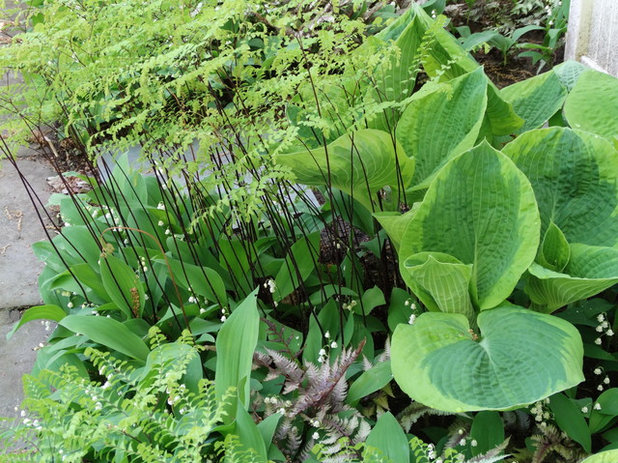
A J Miller Landscape Architecture PLLC
Color Palettes5. Cool tones. Colors in the green, blue and purple spectrum are considered cool colors. Cool colors evoke a sense of calm and freshness. They help us feel relaxed and peaceful. Note how the purple of the Japanese painted fern picks up on the dark stems of the maiden fern, and the tiny bell-shaped flowers of the lily-of-the-valley dance throughout the planting. Delicate and wispy mix beautifully with bold in this enchanting New York garden.
Plant combo:- Northern maidenhair fern (Adiantum pedatum, zones 3 to 8)
- ‘Frances Williams’ plantain lily (Hosta sieboldiana ‘Frances Williams’, zones 3 to 8)
- Lily-of-the-valley (Convallaria majalis, zones 2 to 7)
- Japanese painted fern (Athyrium niponicum var. pictum, zones 3 to 8)
Light requirement: Partial shade to full shade
Water requirement: Regular water
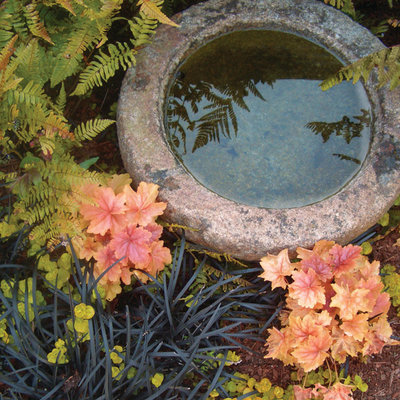
Zeterre Landscape Architecture
6. Warm tones. Colors on the yellow, orange and red end of the spectrum elicit a sense of vibrancy and energy. The vivid color of these ‘Southern Comfort’ coral bells draws attention to the water feature in this San Francisco garden.
Plant combo:- Black mondo grass (Ophiopogon planiscapus ‘Nigrescens’, zones 5 to 10)
- ‘Southern Comfort’ coral bells (Heuchera ‘Southern Comfort’, zones 4 to 8)
- Golden creeping Jenny (Lysimachia nummularia ‘Aurea’, zones 3 to 9)
Light requirement: Partial shade
Water requirement: Regular to occasional water
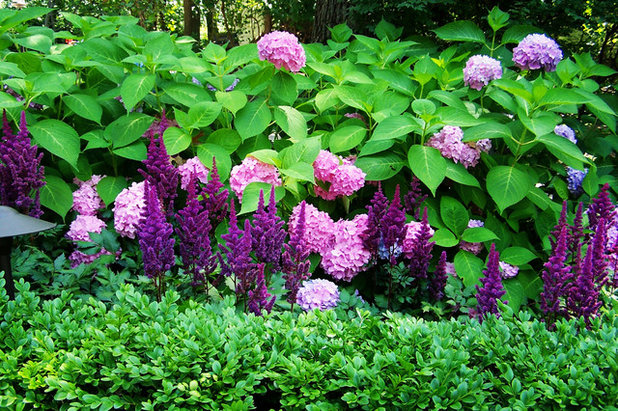
The Carter Rohrer Co.
Flowers7. Tiers of color. Flowers are last but not least. There’s no denying the magic of a garden in full bloom. Perhaps it’s the fleeting nature of flowers that makes them so special. Consider layers of your garden when choosing plants. The tall hydrangeas dominate the background of this border in Indiana, while the astilbes fill the midlayer.
Plant combo:- Endless summer hydrangea (Hydrangea macrophylla ‘Bailmer’, zones 4 to 9)
- ‘Visions’ astilbe (Astilbe chinensis ‘Visions’, zones 4 to 8)
- ‘Glencoe’ boxwood (Buxus ‘Glencoe’, zones 4 to 9)
Light requirement: Partial shade to full shade
Water requirement: Regular water during dry months
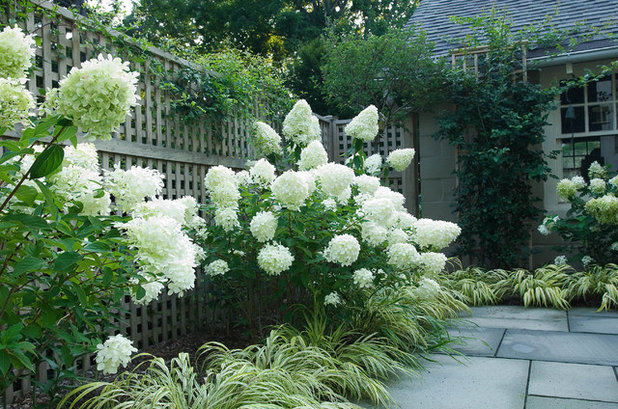
Westover Landscape Design, Inc.
8. All-white garden. A garden with all-white blooms can be just as satisfying as a garden full of color. In this New York garden, ‘Limelight’ hydrangeas look like icing on a cake.
Plant combo:- ‘Limelight’ hydrangea (Hydrangea paniculata ‘Limelight’, zones 3 to 8)
- Golden Japanese forest grass (Hakonechloa macra ‘Aureola’, zones 4 to 9)
Light requirement: Full sun to partial shade
Water requirement: Regular water during dry months
Coming up with a planting plan for a shade garden can be challenging but rewarding. What are your favorite plant combinations for shade? We’d love to see your photos in the Comments section.





